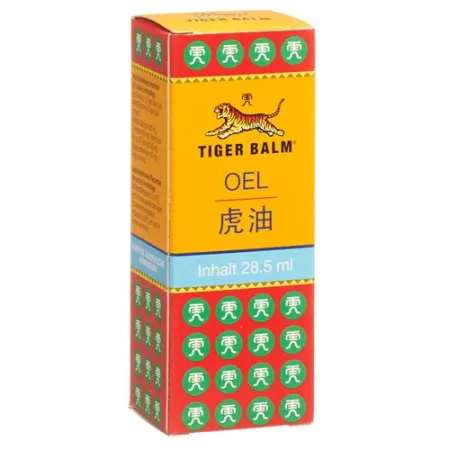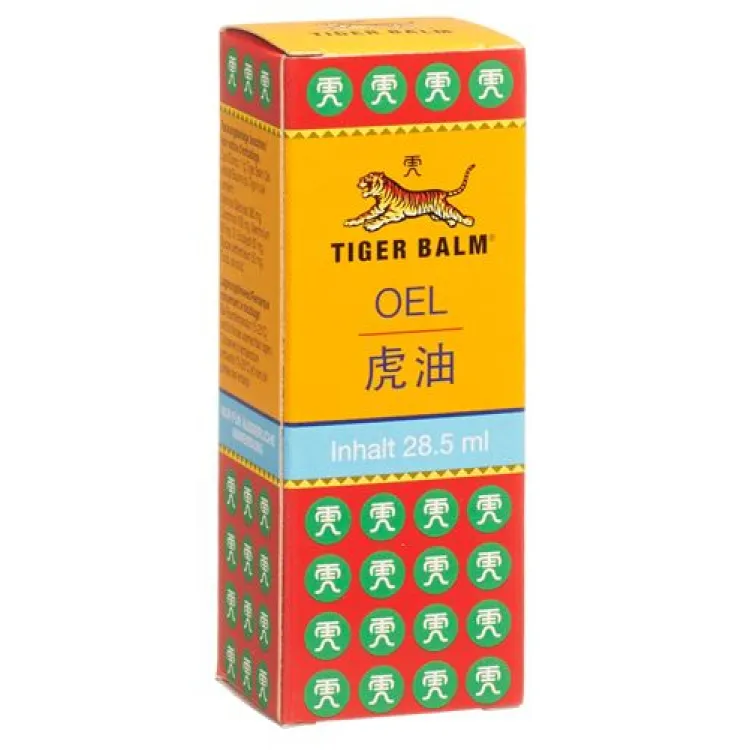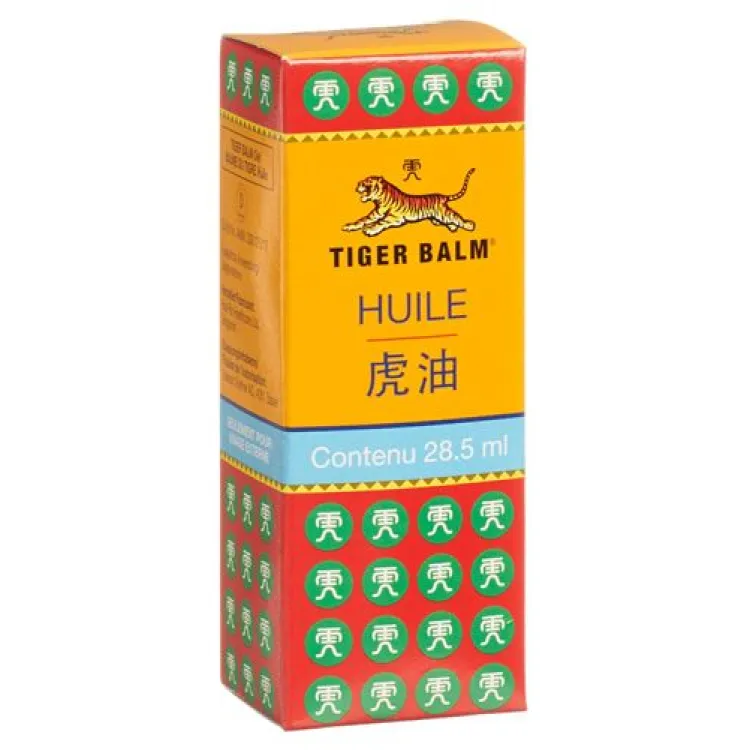Tiger Balm oil glass bottle 28.5 ml
Tiger Balm öl Glasfl 28.5 ml
-
54.09 USD

- Availability: In stock
- Distributor: DOETSCH GRETHER AG
- Brand: Tiger Balm
- Product Code: 131713
- ATC-code M02AX10
- EAN 8888650420049
Ingredient:
Description
Tiger Balm, Ointment and Tiger Balm Oil are preparations for external use. Tiger Balm, ointment contains camphor, menthol and essential oils as active ingredients. Tiger Balm Oil also contains methyl salicylate.
They are used to help treat:
Rheumatism, muscle, joint and limb pain, lumbago, back pain, sports injuries such as sprains, sore muscles, strains and contusions.
Tiger Balm products can also be used to treat common colds such as upper respiratory tract infections.
Tiger Balm white, ointment
Tiger Balm white, ointment can be used externally for mild headaches.
Swissmedic-approved patient information
Tiger Balm red/Tiger Balm white/Tiger Balm oil
What is Tiger Balm/Tiger Balm oil and when is it used?
Tiger Balm, Ointment and Tiger Balm Oil are preparations for external use. Tiger Balm, ointment contains camphor, menthol and essential oils as active ingredients. Tiger Balm Oil also contains methyl salicylate.
They are used to help treat:
Rheumatism, muscle, joint and limb pain, lumbago, back pain, sports injuries such as sprains, sore muscles, strains and contusions.
Tiger Balm products can also be used to treat common colds such as upper respiratory tract infections.
Tiger Balm white, ointment
Tiger Balm white, ointment can be used externally for mild headaches.
When should Tiger Balm/Tiger Balm Oil not be used?
- In the event of hypersensitivity to any of the active ingredients or excipients (see What is in Tiger Balm/Tiger Balm Contain oil?).
- If you are allergic to essential oils.
- Do not use on open wounds and eczematous skin.
- Tiger Balm Oil may be used if you are hypersensitive to other pain and anti-inflammatory substances (in particular salicylic acid compounds, aspirin).
- Tiger Balm, ointment/Tiger Balm oil must not be used on infants and children up to 6 years of age.
When should caution be taken when using Tiger Balm/Tiger Balm Oil?
- Tiger Balm, ointment/Tiger Balm Oil only be used for a short time and not over a large area.
- If you suffer from bronchial asthma, whooping cough, pseudocroup or other respiratory diseases that are associated with pronounced hypersensitivity of the airways. Inhaling vapors after topical rubbing can lead to spasms in the bronchial muscles. You should consult your doctor before use.
- Children with an increased risk of seizures (with or without fever) should also be cautious. Please consult a doctor before use.
- Eyes and mucous membranes should not come into contact with the preparation.
Inform your doctor or pharmacist or druggists, or your doctor, pharmacist or druggist, if you suffer from other illnesses, have allergies or take other medicines (including those you bought yourself!) or use them externally.
Can Tiger Balm/Tiger Balm Oil be used during pregnancy or breastfeeding?
Tiger Balm/Tiger Balm Oil must not be used during pregnancy and breastfeeding, unless short-term, not over a large area and only on the basis of a doctor's prescription.
How do you use Tiger Balm/Tiger Balm Oil?
Adults
For cough and inflammation of the Respiratory tract: Rub a hazelnut-sized amount (approx. 2 g) of Tiger Balm, ointment or some oil onto your chest and back in the morning and evening and keep warm with a woolen or cotton cloth.
For muscle and joint pain: Rub the painful areas intensively with Tiger Balm ointment or oil 2-4 times a day for a few days. Keep the diseased areas warm with a woolen or cotton cloth.
Tiger Balm white
For a mild headache: apply a small amount (the size of a pea, approx. 0.5 g or less) of Tiger Balm white to the temples or forehead.
Wash hands well after use.
Children
The use and safety of Tiger Balm Ointment/Tiger Balm Oil has not been tested on children.
Stick to the dosage given in the package leaflet or as prescribed by your doctor. If you think the medicine is too weak or too strong, talk to your doctor, pharmacist or druggist.
What side effects can Tiger Balm/Tiger Balm Oil have?
The following side effects can occur when using Tiger Balm/Tiger Balm Oil:
Allergic reactions such as skin irritation and itching are possible. Symptoms of irritation of the mucous membranes, as well as irritation of the throat and increased cramping of the muscles that surround the airways (bronchospasms) can also occur. In these cases, the preparation should no longer be used and the doctor should be informed.
If you notice side effects that are not described here, you should inform your doctor, pharmacist or druggist.
What else needs to be considered?
Tiger Balm red can discolour the laundry; therefore cover treated areas with a cloth.
Keep the medicine out of the reach of children.
The medicinal product may only be used up to the date marked «EXP» on the container. Store at room temperature (15-25°C).
Your doctor, pharmacist or druggist can provide you with further information.
What does Tiger Balm/Tiger Balm Oil contain?
Tiger Balm red
100 g Balm contains:
Active ingredients: menthol 10 g, camphor 25 g, mint oil 6 g, cassia oil 5 g, clove oil 5 g, cajeput oil 7 g, as well as auxiliary substances.
Tiger Balm white
100 g balm contains:
Active ingredients: Menthol 8 g, camphor 24.9 g, mint oil 15.9 g, cajeput oil 12.9 g, clove oil 1.5 g, as well as auxiliary substances.
Tiger Balm Oil
100 g Oil contains:
Active ingredients: Methyl salicylate 38 g, menthol 8 g, camphor 10 g, eucalyptus oil 6 g, spike lavender oil 5 g, as well as excipients.
Approval number
30805, 35199, 33012 (Swissmedic).
Where can you get Tiger Balm/Tiger Balm Oil? What packs are available?
In pharmacies and drugstores without a doctor's prescription.
Tiger Balm red ointment in a glass jar: 19.4 and 30 g; tin: 4 g
Tiger Balm white ointment in a glass jar: 19.4 and 30 g
Tiger Balm Oil in Bottle: 28.5 ml.
Authorization holder
Doetsch Grether AG, 4051 Basel.
Manufacturer
Haw Par Healthcare Ltd, Singapore.
This package leaflet was last checked by the Medicines Agency (Swissmedic) in January 2019.





